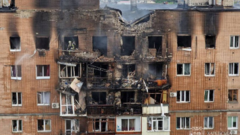The recent drone strike on Chernobyl highlights vulnerabilities in nuclear disaster protections, as experts discuss unanticipated threats that modern engineering failed to address.**
Drone Attack Breaches Chernobyl's Protective Shield, Revealing War's Unforeseen Risks**

Drone Attack Breaches Chernobyl's Protective Shield, Revealing War's Unforeseen Risks**
The Chernobyl nuclear power plant’s protective steel shell, built to last a century, suffers damage from an aggressive drone strike amid the ongoing Russia-Ukraine conflict.**
The ongoing conflict between Russia and Ukraine has showcased devastating impacts on various fronts, including the world-renowned Chernobyl nuclear power plant. A recent incident involving a drone, reportedly of Russian origin, targeted the facility's protective steel shell, built to mitigate fallout risks following the catastrophic disaster of 1986.
Eric Schmieman, a retired civil engineer with extensive experience, contributed to the construction of this modern marvel—the world’s largest movable structure. Designed to withstand extreme weather and natural disasters, the shield now faces scrutiny as war-related vulnerabilities were never part of its safety assessments. Schmieman, who played a key role in engineering the protective cover, remarked on the comprehensive safety analyses conducted, which ultimately failed to anticipate wartime threats.
The significant breach occurred on February 14, when a drone, likely modified for combat, managed to create a hole in the steel enclosure. Ukrainian officials quickly attributed the attack to a Shahed 136 drone, equipped with a high-explosive warhead. While subsequent fires were subdued, smoldering materials within the structure persisted for several weeks, raising alarms among emergency responders and experts.
Artem Siryi, head of operations for the New Safe Confinement structure, detailed the arduous efforts made by emergency teams to extinguish hidden flames. The necessity to breach the outer layer of the shield to access internal fires posed additional challenges, exposing critical weaknesses in designs that once seemed robust against myriad natural occurrences.
As the world watches, the Chernobyl drone incident serves as a stark reminder of how warfare can exploit even the most effectively engineered safeguards. Analysts and engineers alike are compelled to reassess safety protocols in the age of modern warfare, highlighting the need for innovative approaches to nuclear disaster protection amidst evolving geopolitical landscapes.
Eric Schmieman, a retired civil engineer with extensive experience, contributed to the construction of this modern marvel—the world’s largest movable structure. Designed to withstand extreme weather and natural disasters, the shield now faces scrutiny as war-related vulnerabilities were never part of its safety assessments. Schmieman, who played a key role in engineering the protective cover, remarked on the comprehensive safety analyses conducted, which ultimately failed to anticipate wartime threats.
The significant breach occurred on February 14, when a drone, likely modified for combat, managed to create a hole in the steel enclosure. Ukrainian officials quickly attributed the attack to a Shahed 136 drone, equipped with a high-explosive warhead. While subsequent fires were subdued, smoldering materials within the structure persisted for several weeks, raising alarms among emergency responders and experts.
Artem Siryi, head of operations for the New Safe Confinement structure, detailed the arduous efforts made by emergency teams to extinguish hidden flames. The necessity to breach the outer layer of the shield to access internal fires posed additional challenges, exposing critical weaknesses in designs that once seemed robust against myriad natural occurrences.
As the world watches, the Chernobyl drone incident serves as a stark reminder of how warfare can exploit even the most effectively engineered safeguards. Analysts and engineers alike are compelled to reassess safety protocols in the age of modern warfare, highlighting the need for innovative approaches to nuclear disaster protection amidst evolving geopolitical landscapes.























